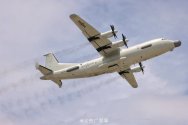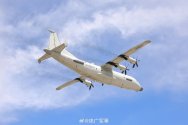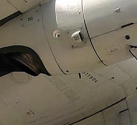That is why I think the next shift in battlefield management will be a migration to unmanned sensor drones that collectively behave as a resilient multi-node multi-spectrum (i.e. multi-band radar + IR) network with distributed control centers and AI augmentation. And yes I can hear snickering about buzzwords to sentence ratio, but the fact remains whether it is KJ600/2000 or E3/2C they remain a single point of failure with a fixed radius of detection. And the number of personnel working on said management is fixed at what number of controllers that single point of failure can carry. And with the ever apparent paradigm shift toward a swarming tactic, the number of targets tracked can and will be overwhelm that single point. That is why I think the current state of affairs of relying on expensive AWACS planes will shift to a scenario where much less expensive autonomous sensor-drones protected by robotic ucavs (where needed) with high bandwidth backhaul to multiple control centers. And to do all that requires computation, computation and more computation. We are at the verge of computational-warfare, and I believe battlefield management is the vanguard of that move. Stepping-off-soapboxNot having air refuelling might be down to other considerations, specifically crew endurance and fatigue.
Air combat controllers are highly intensive and demanding roles, especially against a near peer who can shoot back and seriously challenge your limits. Do you really want people pulling 12h+ shifts doing that kind of role? Someone zoning out and missing a momentary contact could be the difference between detecting or missing a VLO bogey.
You are using an out of date browser. It may not display this or other websites correctly.
You should upgrade or use an alternative browser.
You should upgrade or use an alternative browser.
PLA AEW&C, SIGINT, EW and MPA thread
- Thread starter Sczepan
- Start date
What if the new dish is rotatable but only when needed? Like kj200, the aew plane could operate with two sides fixed. But when needed, arrays can change position. Or even rotate continuously until they need to pause to dwell on something.
If it's two sides, then that just seems like a regular rotodome equipped with a 3D AESA.
TerraN_EmpirE
Tyrant King
E3 SentryAs far as I am aware, planes like AWACS do not typically carry more controllers than work stations to allow airborne shift work. Most models don’t even have physical seats to sit that many more people since much of the cabin space is taken up by equipment.
They can maybe take one or two extra controllers to rotate people out for short breaks, but that’s not the same as having a fresh crew.
NATO have been able to get away with long shifts because goat herders typically don’t present much in the way of air threats. In a near peer conflict, it’s extremely likely that the crew will loose operational effectiveness and need to be rotated out long before the aircraft runs low on fuel.
E7A Wedgetail RAAF tour.
The perk of building your AWACS off a commercial airliner is it comes from the factory with a commercial airliner fixtures built in. You can use the chairs, head and Galley station from the factory. Globaleye, R99, Saab Erieye also have at least additional seats. Even the A50.
What you are saying @plawolf would be accurate for smaller AEW types like E2 Hawkeye or helicopter based AEW which are much smaller.
Because of computerization man power is not as important as it used to be and crew members will rotate. Like anyone whom has flown commercially seats are usable for sleeping though optimally more for naps. Airliners and Air lifters have longer endurance already than fast mover jets. E3’s have stayed on station for over 8 hours which is about the record for a 737 commercially.
Really in peer v near peer AWACS are not going to be doing penetration missions they will stay back with tankers and other conventional aircraft and serve as air traffic control looking for intruders but also vectoring penetrating aircraft to refuel and command. After all AWACS have big radar cross sections and as the Patriot proved against the A50 easy targets for fighters and Air defense systems.
@LuzinskiJ
Fifth generation fighters are designed to serve as mini awacs using directional datalinks to share information. A Drone AWACS really is just a flying communications node connecting low observable datalinks with the Pilots then sorting much of the mission themselves. This is made easier as modern FBW systems off load much of the flying.
@banjex
One of concepts for a future battle management strategy has been to off load work to a ground station. Naval CIC and ground based command centers assuming the communications are available could take the job. Basically the AWACS is just a radar and communications station. However bandwidth and latency are issues.
IMO such might work better for Naval AEW as the AEW is generally flying around a fleet of ships loaded with command centers perfect for such missions and the AEW doesn’t stray far from the mother ship.
Why Chinese Y9 based AWACS lack air refueling? First The PLAAF is still limited in its scope of operations to within easy reach of the mainland. The U.S. and NATO are global. Australia has a large are of operations in the Southern Pacific. China is largely land locked with its pacific coast reach flying right into contested territories.
Second China still has few Tankers. Refueling requires certification and training to keep it safe. If you don’t have the tankers than you don’t have the numbers to maintain such.
Third Reef bases. The Kj500 series was based of the Y9 for a reason and it’s not just that China lacked and indigenous airliner. Tactical Transport aircraft have STOL capabilities baked in for special operations and infiltration missions. Short strip bases like those at Sobi Reef and Mischief reef can serve as bases and refueling points for such aircraft.
The perk of building your AWACS off a commercial airliner is it comes from the factory with a commercial airliner fixtures built in. You can use the chairs, head and Galley station from the factory. Globaleye, R99, Saab Erieye also have at least additional seats. Even the A50.
Actually, that isn't how it works.
Chairs, Lavatories, Galleys etc are BFE (Buyer Furnished Equipment). That is, they are specified by the buyer from approved list of 3rd party option suppliers and negotiated between the buyer and the supplier (not manufacturer). In other words, most commercial jets are "delivered" bare by the manufacturer.
Just a quick look through the vids you posted will show that the seats, seating, galley equipment, etc are all fairly non-standard in make and/or configuration.
The benefit of using a commercial frame really is that they generally come with better cabin insulation and pressurization which directly relates to the ergonomics of the work space in which the crew work in.
A Sea King ASaC7 is going to be noisier, colder and generally more uncomfortable to than a E-2D < A-50 < any commercial jet based AEWC. Stuff that may not matter on a 2 hour sortie starts to become debilitating as the hours drags on.
Another reason, I'd hazard a guess, is that a narrow-body commercial jet (also commonly called a single aisle jet) generally fits the workspace requirement of a AEWC platform better in terms of how you wish to lay out the workstations and access them (from a single aisle). A wide body jet on the other hand (and a transport jet like the Y20 is closer to that) will necessitate a multi aisle arrangement or leave the center empty, both of which may just be wasted space if not required - which indirectly leads to a commercial jet airframe being used to avoid R&D cost on a totally new airframe for a low run AEWC requirement.
TerraN_EmpirE
Tyrant King
Didn’t quite mean it literally. Though the Wedgetail is converted by Boeing the furniture is sourced from the same general supply chain. Custom cabins and Galley like that can come from the business jet market as well. Boeing does do some outfitting for aircraft though yes the majority is done by third parties for the buyer. And as this is an awacs and not a commercial airliner it only need enough of a galley to support a dozen or so rather than a hundred.Actually, that isn't how it works.
Chairs, Lavatories, Galleys etc are BFE (Buyer Furnished Equipment). That is, they are specified by the buyer from approved list of 3rd party option suppliers and negotiated between the buyer and the supplier (not manufacturer). In other words, most commercial jets are "delivered" bare by the manufacturer.
Just a quick look through the vids you posted will show that the seats, seating, galley equipment, etc are all fairly non-standard in make and/or configuration.
The benefit of using a commercial frame really is that they generally come with better cabin insulation and pressurization which directly relates to the ergonomics of the work space in which the crew work in.
A Sea King ASaC7 is going to be noisier, colder and generally more uncomfortable to than a E-2D < A-50 < any commercial jet based AEWC. Stuff that may not matter on a 2 hour sortie starts to become debilitating as the hours drags on.
Another reason, I'd hazard a guess, is that a narrow-body commercial jet (also commonly called a single aisle jet) generally fits the workspace requirement of a AEWC platform better in terms of how you wish to lay out the workstations and access them (from a single aisle). A wide body jet on the other hand (and a transport jet like the Y20 is closer to that) will necessitate a multi aisle arrangement or leave the center empty, both of which may just be wasted space if not required - which indirectly leads to a commercial jet airframe being used to avoid R&D cost on a totally new airframe for a low run AEWC requirement.
As to modifications. To convert for such a role the aircraft is generally stripped to bare parts then rebuilt replacing and augmenting the insulation and wiring. This is especially important for an aircraft like the E7 where it needs to run the new wiring for the Radar and communications as well as provide protection from EMP and radiation. Modifications like this can be done to transport aircraft as well so long as the builder is able to make the changes. The VC130 for example and the Kj500 interior particularly if the builder is willing to reduce the interior cabin space. Which may be done on the A50. But certainly not on much smaller aircraft.
As to Ergonomics that will depend on the builder and whatever they feel is best.
The E3 is technically a narrow body jet. And we see standing three across stations on it.
By the time of the Wedgetail electronics had evolved and they decided to do the two wall mounted stations. Probably to get Max Headroom.
Other modern AWACS like Globaleye have desk stations flanking the center pathway. As a rule though there are almost no clean sheet AWACS in the world save E2 Hawkeye and that had to be because of the Naval requirements.
What if the new dish is rotatable but only when needed? Like kj200, the aew plane could operate with two sides fixed. But when needed, arrays can change position. Or even rotate continuously until they need to pause to dwell on something.
Why not. Implementing Sector scan for a rotodome is a thing. Example being E-2D and apparently Russian A-100.
Well, exactly. I'm not saying that's something super novel, just that it's doable now. Compared to the 3 faces on the KJ-500, each of the 2 faces of the KJ-500 should yield a 10-15% increase in length of the array and a certain increase in overall area of the array. (hard to actually precisely measure where the array is positioned) As we all know, that should translate to either a better/different frequency being used or better resolution at same frequency.Why not. Implementing Sector scan for a rotodome is a thing. Example being E-2D and apparently Russian A-100.
I see it as a complementary system to the KJ-500, not necessarily one which betters the KJ-500 in every regard.
Third Reef bases. The Kj500 series was based of the Y9 for a reason and it’s not just that China lacked and indigenous airliner. Tactical Transport aircraft have STOL capabilities baked in for special operations and infiltration missions. Short strip bases like those at Sobi Reef and Mischief reef can serve as bases and refueling points for such aircraft.
Would it be viable for KJ-600s to be stationed on those SCS island bases instead?
Given how the PLA airbases on those islands are essentially situated right on the front line, they would be prime targets for enemy strikes in any larger-scale, if not all-out war scenario in the WestPac.
In that case, the KJ-600s being cheaper to procure and operate than the KJ-200s and KJ-500s should allow them greater flexibility to operate from shorter runways or temporary airstrips in the SCS region? This would be crucial if or when the runways are damaged by enemy action during wartime.
The JASDF also operates an AEW&C aircraft fleet with 3/4ths of it being the E-2Cs, with plans to procure similar number of E-2Ds as their replacement. I suppose their expected theater of operations in the ECS and Sea of Japan region (i.e. basing out of island airbases and airstrips, which Japan does have plenty of) is the reasoning for such procurement choices?



